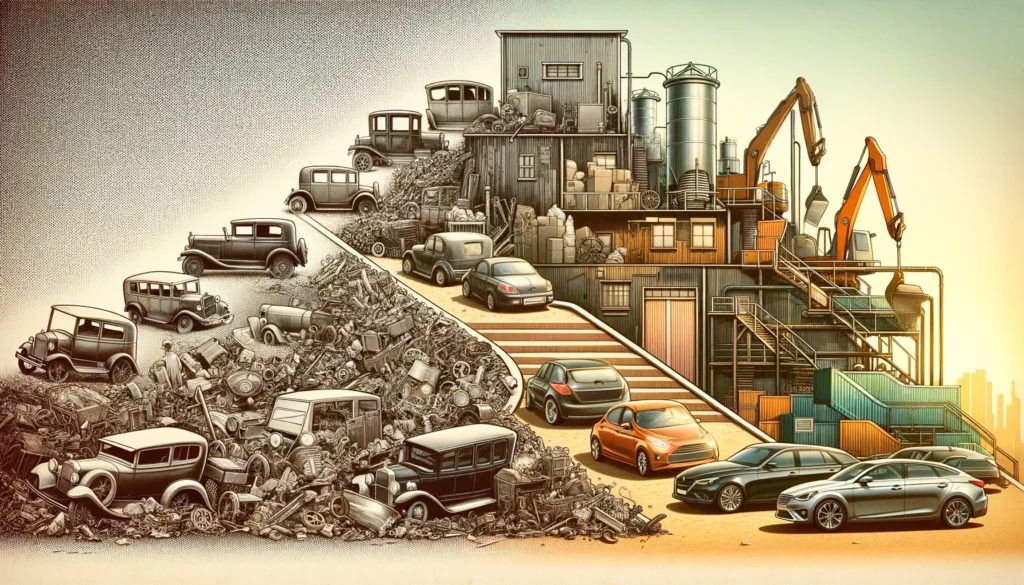The image of a car junk yard might conjure up scenes from post-apocalyptic movies – a dusty wasteland of twisted metal hulks. But beneath that rough exterior lies a surprisingly vibrant ecosystem, one that plays a crucial role in the very industry that creates those gleaming new cars on dealership lots. Car junk yards, also known as salvage yards or auto wreckers, are far from wastelands. they’re treasure troves of parts, and resources, and a testament to responsible car ownership.
The Cycle of Sustainability: Reusing, Repurposing, Recycling
Modern car junkyards operate with a focus on sustainability. Here’s how they contribute to a healthy auto industry cycle:
- Extending a Car’s Life: When a car reaches the end of its road duty due to an accident, age, or mechanical failure, a salvage yard becomes its second chance. Mechanics and car enthusiasts can find a treasure trove of used parts – engines, transmissions, body panels, and more – that breathe new life into older vehicles. This keeps repairable cars on the road longer, reducing the overall demand for brand-new ones, and consequently, lowering the environmental impact of car manufacturing.
- Affordability on the Road: Used parts from junkyards are significantly cheaper than their brand-new counterparts. This affordability is a boon for budget-conscious car owners who need repairs without breaking the bank. It also allows classic car enthusiasts to restore their beloved vehicles without exorbitant costs.
- Environmental Champions: By providing a source for used parts and facilitating car recycling, junkyards divert tons of metal, rubber, glass, and fluids from overflowing landfills. Recycling these materials reduces the need for virgin resource extraction, which can be destructive to landscapes and ecosystems. Additionally, reusing existing parts lowers the overall energy consumption required for new car production.
Beyond Parts: The Car Junk Yard Ecosystem

The impact of junkyards extends far beyond just parts and recycling. Here’s a glimpse into the unseen ways they contribute to the auto industry:
- Job Creation: Junkyards are economic hubs that create jobs in various sectors. From appraisers who determine a car’s value to dismantlers who carefully extract parts, to administrative staff and yard managers, salvage yards provide a livelihood for many within the auto industry.
- Innovation Through Restoration: The ingenuity and passion of mechanics and car enthusiasts who frequent junkyards fuel a culture of restoration and customization. This hands-on approach keeps older car models alive, fostering a deeper appreciation for automotive history and design. These restored cars often find their way into car shows and collections. becoming testaments to the enduring legacy of the automobile.
- A Training Ground for Mechanics: Junkyards serve as practical training grounds for aspiring mechanics. Dismantling cars allows them to gain firsthand experience with various automotive components, their functions, and how they work together. This practical knowledge complements classroom learning and prepares future mechanics for successful careers within the auto industry.
The Future of Car Junk yard: Embracing Green Practices
As the auto industry moves towards electric vehicles and advanced technology, junkyards are adapting as well. Here’s a look at how they’re evolving:
- Evolving Expertise: With the rise of electric vehicles, junkyards are developing expertise in handling electric batteries and related components. This ensures safe and responsible recycling of these specialized parts, preventing hazardous materials from entering the environment.
- Embracing Green Technology: Modern junkyards are increasingly adopting eco-friendly practices. This includes using advanced dismantling techniques that minimize fluid spills and implementing responsible waste management processes for non-recyclable materials.
- Partnering with Manufacturers: There’s a growing trend of collaboration between car manufacturers and salvage yards. Responsible recycling of specific car parts and materials is possible thanks to this process. This creates a more closed-loop system within the auto industry, reducing waste and resource consumption.
Related:
Gear Up for Adventure: What Hidden Features Can Transform Your Car Into a Road Trip Companion?
Conclusion: A Brighter Future Fueled by Responsibility
Car junkyards are no longer just graveyards for old cars; they’re vital cogs in the wheel of a sustainable auto industry. By promoting affordability, extending car lifespans, and prioritizing responsible recycling, they contribute significantly to a greener future for automobiles. The industry is embracing electric vehicles and advanced technologies. This shift will require junkyards to adapt and innovate in order to ensure a responsible and sustainable path forward. The next time you see a car junkyard, don’t dismiss it as just a pile of rusty relics. Instead, consider it a treasure trove of resources and a testament to the responsible future of the auto industry.





